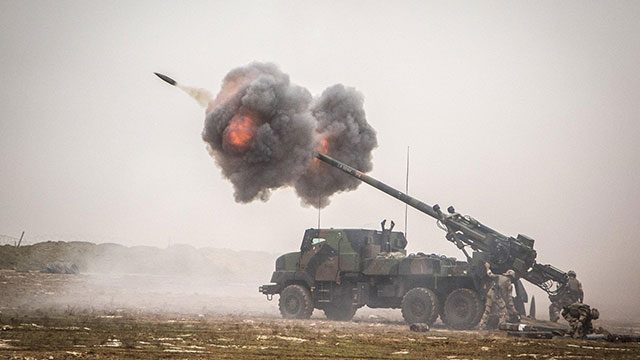French President Emmanuel Macron has confirmed, according to sources, that all Caesar self-propelled howitzers produced in France throughout 2025 will be delivered to Ukraine, a move signaling robust Western support for Kyiv amid its ongoing defense against Russian forces.

According to sources, this commitment translates to 12 howitzers per month, totaling 144 units for the year, as France ramps up production to meet Ukraine’s pressing need for advanced artillery.
The announcement, reported on platforms like X, underscores France’s strategic pivot to prioritize Ukraine’s military requirements, potentially at the expense of other international clients. This decision comes as Ukraine intensifies its reliance on mobile, precise artillery to counter Russian advances, while France navigates complex geopolitical and industrial challenges.
The Caesar, or Camion Équipé d’un Systılmış d’Artillerie, is a 155mm self-propelled howitzer developed by Nexter Systems, now part of the Franco-German KNDS group. Renowned for its mobility and firepower, the system has become a cornerstone of modern artillery, particularly in Ukraine’s arsenal.
Since Russia’s invasion in February 2022, France has steadily increased its deliveries of Caesars to Ukraine, with a total of 67 units supplied by October 2024, according to reports from Politico. The latest pledge marks a significant escalation, reflecting both France’s industrial capacity and its geopolitical alignment with NATO allies supporting Kyiv.
France’s production of the Caesar has seen a remarkable evolution. In 2023, Nexter manufactured six howitzers per month, equating to 72 annually, spurred by heightened demand following Russia’s aggression.
By 2024, production increased to eight units monthly, or 96 per year, as Nexter optimized its assembly lines. Reports indicate that France aims to produce 12 howitzers per month in 2025, a goal articulated by French Armed Forces Minister Sébastien Lecornu in April 2024 during a presentation alongside U.S. Secretary of State Antony Blinken.
This target, if met, would enable the delivery of 144 Caesars to Ukraine, significantly boosting Kyiv’s artillery capabilities. Lecornu emphasized that production times have been halved from 30 months to 15, a testament to France’s shift to a “war economy” model, as championed by Macron.
The Caesar’s design prioritizes mobility, precision, and rapid deployment, making it ideal for Ukraine’s dynamic battlefields. Mounted on a 6×6 truck chassis, typically a Renault Sherpa, the system weighs under 18,000 kilograms, allowing speeds of up to 90 kilometers per hour on roads and 50 kilometers per hour off-road.
Its 155mm/52-caliber gun can fire standard NATO shells to a range of 40 kilometers, with extended-range munitions like the Velocity Enhanced Artillery Projectile reaching up to 42 kilometers. High-precision rounds, such as the GPS-guided Excalibur or the anti-armor BONUS, extend its reach to 50 kilometers, enabling Ukraine to strike Russian positions with devastating accuracy.
The Caesar’s automated fire control system, ATLAS, integrates data from drones, forward observers, and radar systems like COBRA, facilitating “shoot-and-scoot” tactics that minimize exposure to counter-battery fire. With a crew of three to five, the system can fire six rounds per minute and deploy its first shot in under 60 seconds, offering unmatched responsiveness.
Variants of the Caesar cater to diverse operational needs. The 6×6 model, used by France and Ukraine, is lighter and more cost-effective, ideal for rapid maneuvers. An 8×8 version, built on a Tatra T815 chassis, offers greater stability and payload capacity, as adopted by Denmark, the Czech Republic, and Lithuania.
A next-generation Caesar NG, currently in development, promises enhanced armor, hybrid propulsion, and advanced electronics, including artificial intelligence for improved targeting, though it is not expected before 2026. Compared to competitors, the Caesar stands out for its agility.
Germany’s PzH 2000, while heavily armored, is slower and less suited for rapid repositioning. Ukraine’s domestically produced Bohdana, though cost-effective, lacks Caesar’s advanced fire control and range. Russia’s 2S19 Msta-S, a tracked 152mm howitzer, offers comparable firepower but is hindered by logistical constraints and vulnerability to drone strikes.
Ukraine’s military has leveraged Caesar’s capabilities since May 2022, when France began deliveries. By February 2025, 30 French-supplied 6×6 Caesars and 19 Danish 8×8 units were in service, though seven were reported destroyed and three damaged, per Wikipedia data.
Ukrainian forces have used the Caesar to devastating effect, destroying Russian command posts, artillery batteries, and armored vehicles. In 2023, near Bakhmut, Caesars paired with drones and COBRA radars eliminated Russian artillery positions, showcasing their precision in counter-battery roles.
The systems’ mobility has allowed Ukrainian units to evade Russian Lancet drones and counterfire, a critical advantage in a war where artillery duels dominate. However, the intense operational tempo has strained the howitzers, with Ukrainian forces reporting accelerated wear on gun barrels, necessitating frequent maintenance and spare parts from Nexter, as we noted in February 2025.
The commitment to deliver 144 Caesars in 2025 could transform Ukraine’s artillery landscape. With each howitzer costing between €3 million and €4 million, the total value of the deliveries exceeds €430 million, raising questions about funding.
France has previously drawn from a €200 million Ukraine support fund, as Lecornu stated in January 2024, and has secured co-financing from allies like Denmark for earlier batches. Recent reports suggest France may use interest from frozen Russian assets to finance maintenance, as announced by Foreign Trade Minister Jean-Noël Barro in May 2025.
However, the scale of the 2025 commitment may require contributions from the European Union’s Peace Facility or other NATO members, though no firm pledges have been confirmed. Ukraine’s ability to sustain these systems hinges on a steady supply of 155mm shells, a challenge given NATO’s production constraints.
France plans to deliver 80,000 shells in 2024, up from 30,000 in 2022, but Ukrainian forces consume 5,000 to 15,000 shells daily, according to Reuters.
For France, dedicating its entire 2025 Caesar production to Ukraine carries significant implications. Nexter’s Bourges facility, which tripled output from two to six units per month by early 2023, has invested €300 million in raw materials to sustain this pace.
The push to 12 units monthly demands further resources, potentially straining supply chains for components like electronics and gun barrels. France’s own military, which operates 72 Caesars, has ordered 109 Caesar NG units for delivery between 2026 and 2030, suggesting domestic stocks may not be immediately affected.
However, other clients, including Croatia, Estonia, and Lithuania, face delays. Croatia, which signed a framework agreement for 30 Caesars in June 2024, aims to acquire them by late 2025, while Estonia received its first six of 12 ordered units in January 2025. These nations, along with potential buyers like Brazil and Colombia, may see their contracts deferred, risking France’s reputation as a reliable supplier.
Historically, the Caesar has proven its worth in diverse theaters. French forces deployed it in Afghanistan, Mali, and Iraq, where its mobility and precision supported counterinsurgency and anti-ISIS operations. In Ukraine, its role has shifted to high-intensity warfare, exposing both strengths and limitations.
The system’s lightweight design, while advantageous for mobility, offers minimal armor, making it vulnerable to shrapnel and drones. Ukrainian feedback has prompted Nexter to explore upgrades, including AI-enhanced targeting and integration with loitering munitions, as Lecornu noted in January 2024.
These adaptations reflect a broader trend in artillery modernization, where mobility and precision are prioritized over heavy armor, as seen in systems like South Korea’s K9 Thunder or Israel’s ATMOS 2000.
France’s decision aligns with a global resurgence of artillery as a decisive battlefield factor. The war in Ukraine has underscored the centrality of long-range fires, with NATO nations like Poland and Germany expanding their arsenals.
Poland’s acquisition of 212 K9 Thunders and Germany’s upgrades to the PzH 2000 highlight this shift. Yet, Caesar’s export success—used by Indonesia, Thailand, and Saudi Arabia—faces competition from Elbit’s ATMOS, which won a Brazilian contract in 2024. France’s focus on Ukraine may cede market share to rivals, particularly if production bottlenecks emerge.
Geopolitically, Macron’s pledge strengthens France’s leadership within NATO and the EU, positioning it as a key supporter of Ukraine alongside the United States and Germany. Since 2022, France has provided €3.8 billion in military aid to Kyiv, including SCALP missiles and Mirage 2000 jets, per Euromaidan Press.
However, prioritizing Ukraine risks straining relations with allies awaiting deliveries. The absence of public contracts for 2025 suggests Nexter may lack alternative orders, making Ukraine the default recipient. This dynamic raises questions about France’s long-term export strategy and its ability to balance regional security commitments.
Caesar’s combat record in Ukraine offers a glimpse of its potential impact. In 2022, near Kherson, Caesars destroyed Russian supply depots, enabling Ukrainian advances. Their integration with drones and NATO intelligence has amplified their effectiveness, though barrel wear and ammunition shortages remain hurdles.
The 144 additional units could equip multiple Ukrainian brigades, each requiring six to eight howitzers, enhancing Kyiv’s ability to conduct sustained offensives. Yet, without corresponding increases in shell production, their operational tempo may be constrained.
France’s commitment to Ukraine reflects a calculated strategic choice, driven by the urgency of the conflict and Caesar’s proven efficacy. For Kyiv, the influx of howitzers promises to bolster its defenses, particularly in contested regions like Donetsk. For Paris, the move reinforces its role as a defense powerhouse but tests its industrial and diplomatic agility.
As Nexter scales production, the world watches whether France can sustain this pace without compromising its own forces or alienating partners. The absence of transparent funding details and the reliance on allied support leave open the question: can France deliver on its ambitious promise without unforeseen costs?
***
Follow us everywhere and at any time. BulgarianMilitary.com has responsive design and you can open the page from any computer, mobile devices or web browsers. For more up-to-date news, follow our Google News, YouTube, Reddit, LinkedIn, and Twitter pages. Our standards: Manifesto & ethical principles.

